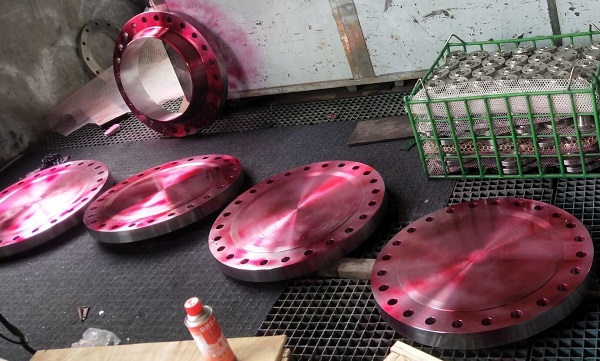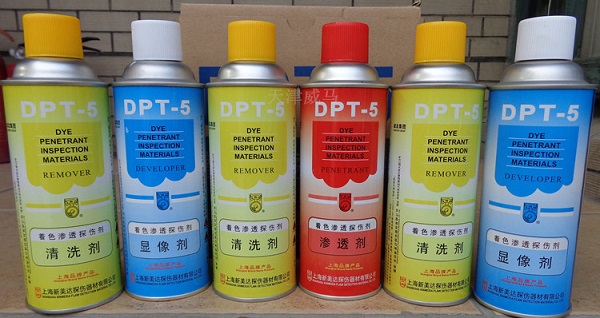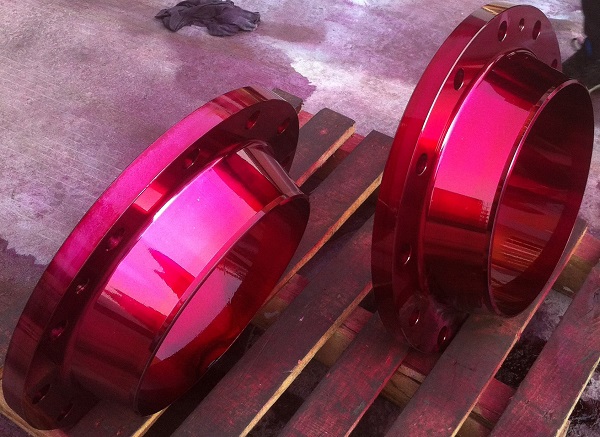Categories
- Pipe & Tube (18)
- Flange & Fitting (97)
- Fastener & Gasket (12)
- Valve & Pump (18)
- Base Material (11)
- Equipment (8)
- Application (30)
- Technical (110)
Liquid penetrant testing is a nondestructive testing method for detecting discontinuities that are open to the surface of the stainless steel flange. These discontinuities include cracks, seams, laps, cold shuts, laminations, isolated porosity, through leaks, or lack of fusion. Stainless steel flanges, especially austenitic and duplex, may be subject to cracking if the forging temperature or operation is inappropriately controlled. Such possible defects shall be detected to avoid catastrophic failure in service. The stainless steel flanges may be manufactured in accordance with ASME B16.5, ASME B16.47, API 6A, EN 1092-1, BS 4504, JIS B2220, AS 2129, or GOST 12815, and other international standards.

The liquid penetrant testing for stainless steel 316/316L dual-certified flanges, made in accordance with ASME B16.5, supplied to the UK.
There are many liquid penetrant testing methods for stainless steel flanges. The most often used method is the visible penetrant examination utilizing the solvent-removable process. This test method is applicable to in-process, final, and maintenance examination. The visible penetrant testing uses a penetrant that can be seen in visible light. The penetrant is usually red, so that resultant indications produce a definite contrast with the white background of the developer. Visible penetrant indications must be viewed under adequate visible light.
Liquid penetrant testing indicate the presence, location and, to a limited extent, the nature and magnitude of the detected continuities. The visible penetrant testing with solvent-removable process is intended primarily for portability and for localized areas of examination, utilizing minimal equipment.The test conducted shall depend on the design and service requirements of the stainless steel flange being tested.
The visible & solvent-removable liquid penetrant testing materials consist of a family of reagents such as visible penetrant, solvent remover, and developer. There are many proprietary reagents available in the market. Combined use of reagents from different producers is not permitted. The usage of each reagent shall strictly follow manufacturer’s recommendations.

The reagents for liquid penetrant testing: penetrant, remover, and developer.
The visible, solvent-removable liquid penetrant is a red-color reagent, which penetrates into surface discontinuities of the stainless steel flanges. It is formulated so that excess surface penetrant can be removed by wiping with dry, clean, lint-free cloth, and repeating the operation until most of the penetrant has been removed. The remaining traces shall be removed by wiping the surface with clean, lint-free cloth lightly moistened with the solvent remover. The solvent remover function by dissolving the penetrant, making it possible to wipe the surface clean and free of residual penetrant. The developer forms a translucent or white absorptive coating that aids in bringing the penetrant out of surface discontinuities through blotting action, thus increasing the visibility of the indications.

Liquid penetrant testing for weld neck flanges made from ASTM A182 F304, ASME B16.5 Class 150 16″ STD, supplied to Bucharest, Romania.
The following general procedure applies to the visible, solvent-removable penetrant examination for stainless steel flanges:
ASTM E165, ASTM E1220, EN ISO 3452, EN 571, EN 10228-2, JIS Z 2343, DIN 54152, NF A04 315-2, BS 6443.
